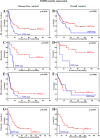Epidermal growth factor receptor (EGFR) is an independent adverse prognostic factor in esophageal adenocarcinoma patients treated with cisplatin-based neoadjuvant chemotherapy
- PMID: 25216514
- PMCID: PMC4196151
- DOI: 10.18632/oncotarget.2268
Epidermal growth factor receptor (EGFR) is an independent adverse prognostic factor in esophageal adenocarcinoma patients treated with cisplatin-based neoadjuvant chemotherapy
Abstract
Neoadjuvant platin-based therapy is accepted as a standard therapy for advanced esophageal adenocarcinoma (EAC). Patients who respond have a better survival prognosis, but still a significant number of responder patients die from tumor recurrence. Molecular markers for prognosis in neoadjuvantly treated EAC patients have not been identified yet. We investigated the epidermal growth factor receptor (EGFR) in prognosis and chemotherapy resistance in these patients. Two EAC patient cohorts, either treated by neoadjuvant cisplatin-based chemotherapy followed by surgery (n=86) or by surgical resection (n=46) were analyzed for EGFR protein expression and gene copy number. Data were correlated with clinical and histopathological response, disease-free and overall survival. In case of EGFR overexpression, the prognosis for neoadjuvant chemotherapy responders was poor as in non-responders. Responders had a significantly better disease-free survival than non-responders only if EGFR expression level (p=0.0152) or copy number (p=0.0050) was low. Comparing neoadjuvantly treated patients and primary resection patients, tumors of non-responder patients more frequently exhibited EGFR overexpression, providing evidence that EGFR is a factor for indicating chemotherapy resistance. EGFR overexpression and gene copy number are independent adverse prognostic factors for neoadjuvant chemotherapy-treated EAC patients, particularly for responders. Furthermore, EGFR overexpression is involved in resistance to cisplatin-based neoadjuvant chemotherapy.
Conflict of interest statement
The authors declare that they have no conflicts of interest.
Figures



References
-
- Ajani JA, Barthel JS, Bentrem DJ, D’Amico TA, Das P, Denlinger CS, Fuchs CS, Gerdes H, Glasgow RE, Hayman JA, Hofstetter WL, Ilson DH, Keswani RN, Kleinberg LR, Korn WM, Lockhart AC, et al. Esophageal and esophagogastric junction cancers. J Natl Compr Canc Netw. 2011;9(8):830–887. - PubMed
-
- Siegel R, Naishadham D, Jemal A. Cancer statistics, 2013. CA Cancer J Clin. 2013;63(1):11–30. - PubMed
-
- Pohl H, Sirovich B, Welch HG. Esophageal adenocarcinoma incidence: are we reaching the peak? Cancer Epidemiol Biomarkers Prev. 2010;19(6):1468–1470. - PubMed
-
- Cunningham D, Allum WH, Stenning SP, Thompson JN, Van de Velde CJ, Nicolson M, Scarffe JH, Lofts FJ, Falk SJ, Iveson TJ, Smith DB, Langley RE, Verma M, Weeden S, Chua YJ, Participants MT. Perioperative chemotherapy versus surgery alone for resectable gastroesophageal cancer. N Engl J Med. 2006;355(1):11–20. - PubMed
-
- Siewert JR, Lordick F, Ott K, Stein HJ, Weber WA, Becker K, Peschel C, Fink U, Schwaiger M. Induction chemotherapy in Barrett cancer: influence on surgical risk and outcome. Ann Surg. 2007;246(4):624–628. discussion 628-631. - PubMed
Publication types
MeSH terms
Substances
Supplementary concepts
LinkOut - more resources
Full Text Sources
Other Literature Sources
Medical
Research Materials
Miscellaneous

